How farmers in potato ‘world capital’ deal with soil erosion and disease
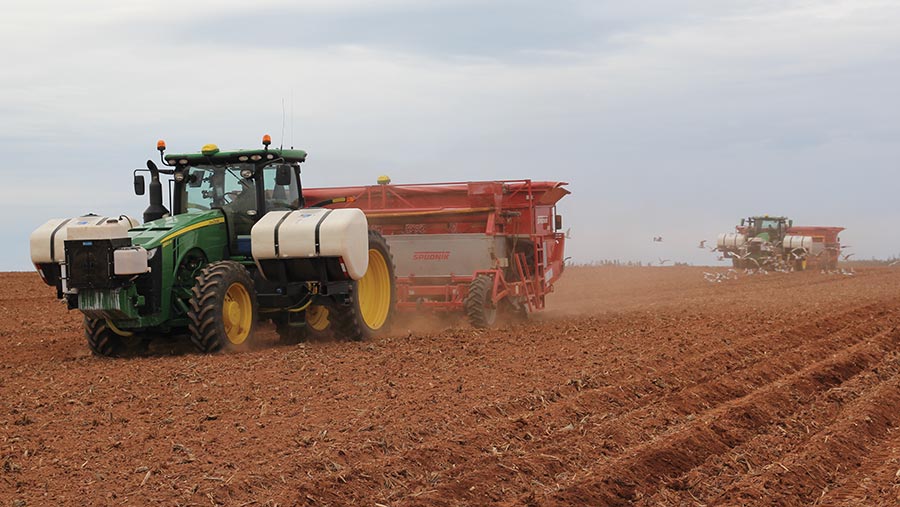 © PEI
© PEI Prince Edward Island in eastern Canada claims to be the potato capital of the world based on production per capita, with an annual harvest of 1.45m tonnes. This equates to 10t of potatoes per head of its 150,000 population.
Elizabeth Irving, who runs Indian River Farms alongside her grandfather and mother, describes its iconic iron-red, fine sandy loam soils – common to large parts of the province and ideal for growing potatoes – as the business’ prize asset.
See also: Can maincrop potatoes be grown in a regenerative system?
But Prince Edward Island’s (PEI’s) undulating topography and maritime climate present a major threat to its sustainability.
On average, the island serves up more than 1,000mm of annual rainfall, harsh winter freeze-thaw cycles and stubbornly high winds from month to month.
“My first thought when asked about my greatest challenge always turns to soil erosion.
“We invest so much into our soils and if you lose it, that investment goes with it, too. It’s something we’ve been working hard to manage,” she explains.
Concern for soils
Soil degradation has long been a concern for the Island’s administration, with long-term studies over recent decades showing a steady reduction in organic matter in intensive arable areas.
In 2001, some 40% of PEI’s potato crops were grown in less than one in three rotations, making tillage frequent and intense, while declining livestock numbers have deprived many farms of vital organic matter and nutrients to return to soils.
Farm facts
Indian River Farms, Kensington, Prince Edward Island, Canada
- Farming 860ha of processing potatoes
- 40% of potato area irrigated under centre pivots
- Rotation split into two depending on soil type/potato early dying complex risk
- Half is barley-potatoes-barley, the other half oil radish-potatoes-corn
- Free-draining, iron-rich sandy loam soils
- 16 full-time staff, rising to 40 in peak periods
The resulting lower water holding capacity and a trend to less frequent, but more intense rainfall events present significant erosion risk to exposed soil, and where soil compaction is also a factor, such as after harvesting potatoes in a wet autumn, risk is even greater.
There is a knock-on effect on the island’s water quality, with sediment and nutrients potentially all ending up in groundwater.
Action has been taken by the PEI government to encourage adoption of practices designed to combat the problem, with financial incentives on offer.
Elizabeth says historical measures have included berms, buffer zones and grassed waterways, with Department of Agriculture-funded software helping farms design and layout these measures for maximum environmental benefit.
Berms reduce the velocity of water flow or direct it to areas that are not susceptible to erosion, subsequently reducing adverse effects on running water on exposed topsoil.
Hay mulching, whereby a hay crop is grown and baled before spreading on to potato fields post-harvest to slow down surface run-off, is another practice encouraged to mitigate erosion.
Lastly, strip cropping, where a variety of crops are established in alternating strips in a single field helps reduce erosion, especially on sloping land.
Changing ways
More recently, the Living Laboratories Initiative has connected farmers, researchers, and other industry stakeholders to co-develop and test practices and technologies to protect soil and water quality.
These initiatives have prompted Indian River Farms to change some of its agronomic practices, with the major tweaks including cultivation timings and the introduction of cover crops where possible.
According to the latest Canadian government farm census, PEI farmers are now most likely of all provinces to plough down cover crops, with 29.2% saying they use green manures, compared with just 8.6% nationally.
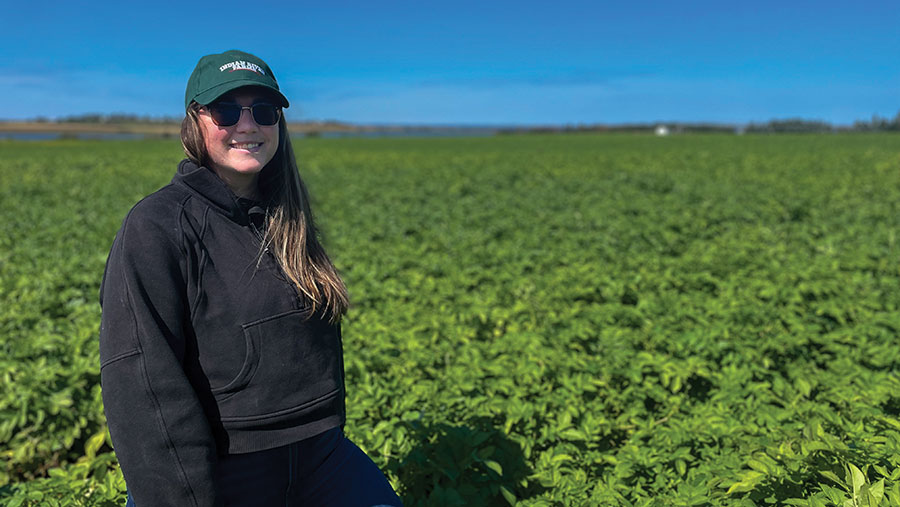
Elizabeth Irving in crop of Russet Burbank potatoes © Adam Clarke
Furthermore, 21.9% say they establish a cover crop to protect soil over winter, which is double the national adoption rate of 10.7%.
“We don’t do any fall tillage now and we were trying to broadcast a green cover after potato harvest, depending on the season.
But past 15 October, it usually gets too cold for anything to germinate and establish other than slowly, so it isn’t easy,” says Elizabeth.
Early dying complex
The introduction of cover crops has also been driven by tackling the business’ most significant crop health challenge, potato early dying complex (PED), which is one of the most economically damaging issues for North American potato producers.
Root lesion nematodes (see “PEI’s root-lesion nematode problem”) interact with fungi such as verticillium dahlia – the main causal agent of verticillium wilt – resulting in disease complexes that exacerbate damage to potato crops.
Both pathogens and pest can act alone to limit yield in potato crops if present at high enough levels, but when the two work together, the impact can be devastating.
It is thought that other pathogens such as Rhizoctonia solani and black dot can contribute to the PED complex, which affects plant health well before crop maturity, reducing bulking and marketable yield.
Initially, lower leaves die, then stems and, in severe cases, stem end vascular browning is seen in tubers.
Verticillium wilt is favoured by moist, lighter texture and warm soils and tends to occur most frequently in wetter, low-lying areas of fields such as sprayer wheelings and machinery entrance points.
Wetter soils are thought to promote shallow root growth, and this tends to accelerate foliar senescence caused by PED.
Management of verticillium during the growing season is limited to optimising nitrogen and phosphorus rates which reduces – but does not eliminate – the severity of wilt symptoms.
For susceptible variety Russet Burbank, Indian River Farms is boosting its nitrogen nutrition with an additional weekly 2-3kg/ha of N in foliar urea (20% N) form, added to fungicide applications.
“Other environmental stresses such as drought also contribute to the problem.
“We’re trying to get a handle on the effects of all the crops in our rotation on nematode populations, as it’s by far our biggest constraint on yield.
“When a field goes down in August before the crop matures, it really is sad to see,” says Elizabeth.
Desirable trait
When it comes to choosing a cover crop, a desirable trait is being a poor host to root-lesion nematodes to minimise subsequent risk of PED.
Initially, Elizabeth looked at sorghum-Sudangrass, buckwheat and Caliente 99 Indian mustard, with the mustard found to give the best suppression of root-lesion nematode ahead of the potato crop from the farm’s own soil testing.
“With the Indian mustard, we struggled to get enough moisture when we wanted to cut and seal it in the ground, so much so that we were getting started at 4am to catch the dew, as our Julys have been so dry recently,” she explains.
In 2019, a management decision was made to change the farm’s source of agronomic advice after trying different advisers from western states of the US and locally on PEI.
With a Scottish family connection – the Irving family moved to PEI in the late 18th century – and a climate more like Scotland than western Canada, they looked east across the Atlantic and to Scottish Agronomy senior agronomist Eric Anderson.
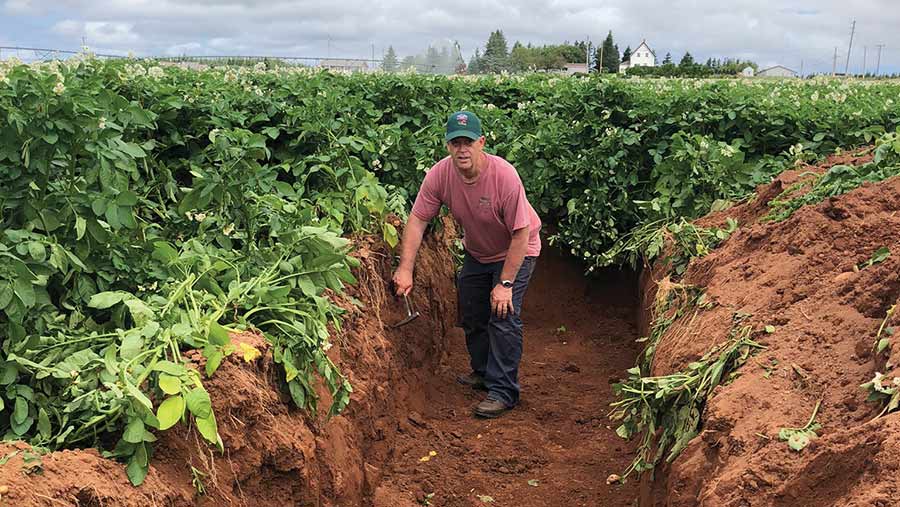
Scottish Agronomy senior agronomist Eric Anderson in PEI soil pit © PEI
Elizabeth says working with Eric has been a valuable process, as he brings fresh insights and practices that aren’t typical on PEI although the environmental conditions are quite similar.
“We have taken some of the things we had already introduced to solve challenges, like erosion and nematodes, and elevated them to another level. We are very happy with the results,” she says.
Subsoiling shift
One of the first changes since hiring Eric was to move rotational subsoiling operations from just before potatoes to immediately after their harvest.
Each of the three potato harvest teams consists of two six-bed windrowers and one three-bed harvester.
To keep up with the sheer volume of potatoes being harvested, trucks with rear twin axles, each fitted with 11R225 tyres, run alongside the harvester to haul potatoes back to store.
Prince Edward Island potato industry
- Grew a fifth of Canada’s total area of potatoes in 2021 (34,508ha)
- Total revenues from PEI potatoes in 2020 was $371.8m (£223.9)
- Potato crops are 60% processing, 30% fresh, 10% seed
- The potato industry employs about 12% of PEI’s workforce
- About 1.25m tonnes are shipped around Canada and overseas annually
Each axle has a weight of 10t, which can cause compaction in the lower subsoil when the soil is wet and causes increasing and deeper compaction irrespective of surface contact pressure.
The resulting poor water penetration through the soil profile exacerbates run-off and soil erosion risk.
“By removing the compaction and increasing porosity, water can infiltrate down into the subsoil during the winter months and soil erosion recorded at the farm has markedly fallen over the past two season,” he explains.
This has also supplemented the effectiveness of establishing a green cover immediately after potatoes.
Instead, the Caliente 99 Indian mustard has been switched out for Bento oil radish, which now holds its own place in a new one-in-four rotation across 50% of the potato-growing fields at highest risk of erosion and root-lesion nematodes.
The oil radish is established the season before potatoes, in late May or early June, when conditions for plant growth are improving and grown on for about 10 weeks before being flailed 46cm from the ground.
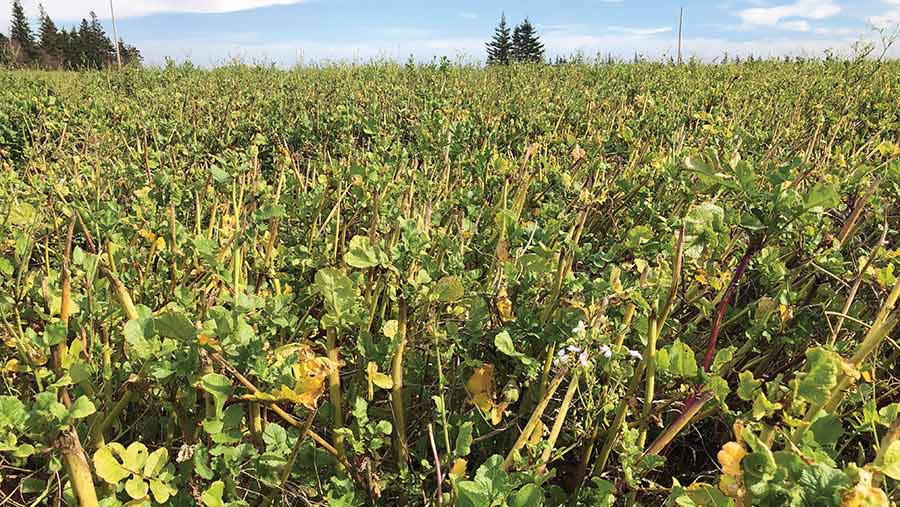
Oil radish after flailing © PEI
Regrowth encouraged
Eric says the aim is to leave three leaf axials intact to encourage regrowth, which extends the biofumigation effects, from 10 to about 20 weeks to maximise nematode suppression.
The oil radish is flailed again before hard frosts kill it off and a significant and deep root system is left to help maintain good soil structure, leave legacy root channels and aid drainage over winter.
This also helps rooting of the potato crop planted the following May.
Elizabeth adds that a major practical advantage of oil radish is that, unlike mustard, it does not need chopping, incorporating, and sealing into the soil to have a biofumigation effect.
“For me, that is a huge advantage, because it stimulated weed growth and we were leaving the soil exposed for several weeks. We don’t like seeing that red dirt for too long.”
Integrated strategy
While published research showing a statistically significant reduction in root-lesion nematodes is lacking, the farm’s own work demonstrates a very useful effect as part of its wider integrated control strategy.
This includes timely spring cultivations when compaction risk is low to avoid hindering rooting and stressing crops.
In-furrow application of Velum Prime (fluopyram) at planting helps protect developing roots, while adequate nutrition and irrigation minimises crop stresses such as drought.
Varietal susceptibility to verticillium is another major consideration, with the moderately susceptible Russett Burbank historically the main cultivar grown at Indian River Farms.
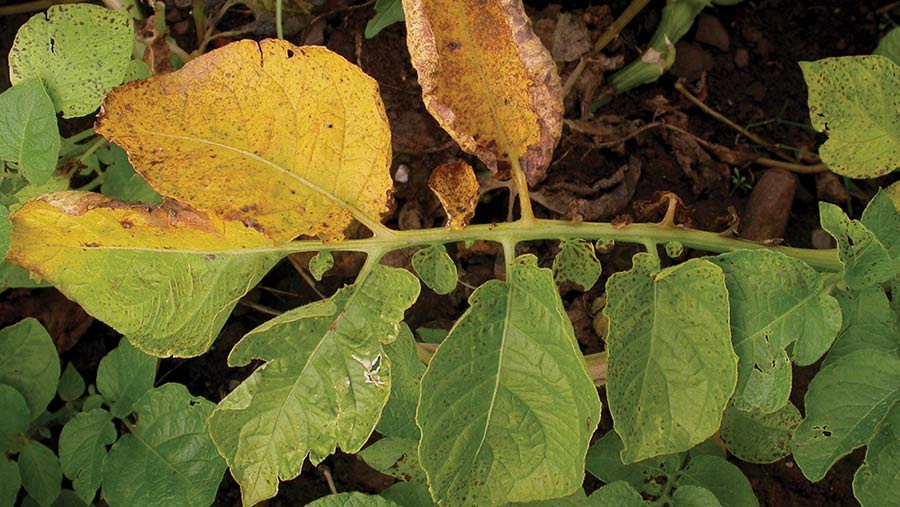
Typical leaf symptoms of verticillium wilt © PEI
Although it remains the main variety, Elizabeth is now adding genetic diversity into their 800+ha of processing potatoes grown for Cavendish Farms.
Alternatives include the more resistant Ranger Russet, Alverstone Russett, Prospect, Althea and Mountain Gem varieties, grown alongside “tried and true” Russet Burbank.
“Their spread of maturity dates without compromising on yield also helps logistically at harvest,” she adds.
PEI’s root-lesion nematode problem
Sampling indicates that the root-lesion nematode, PratyIenchus penetrans, is the dominant species of plant-parasitic nematode found in potato roots and Prince Edward Island (PEI) soils.
Little is known about the life cycle of root-lesion nematodes under field conditions, with almost all the information available originating from studies conducted in controlled conditions.
Management interventions are often focused on limiting nematode reproduction before planting crops and include the application of nematicides, and cultural practices such as crop rotation, cover crops, biofumigation, and biological control.
To put the challenge into context, a study in the 1990s calculated that 15, 50 and 150 root-lesion nematodes per 100cu cm (about 0.1kg) of soil in the presence of Verticillium dahliae would result in 36, 60 and 75% reductions in potato tuber yield, respectively.
More recent studies have shown high populations of verticillium and root-lesion nematodes, with one PEI Potato Board survey in 2017 finding nematodes in 100% of fields, with an average level of 2,700/kg soil.
The numbers for both are far higher than any population in the UK due to a legacy of growing potatoes and susceptible host crops on very tight rotations over a very long period of time.

